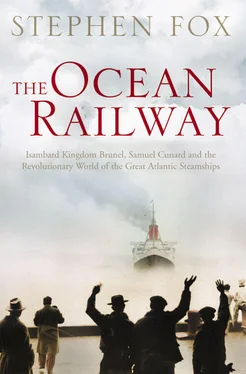The first tea shiparrived in Halifax a year later, smelling like a gigantic teapot, with 6517 chests from Canton. Customers snapped them up in a public sale at the Cunard warehouse. For the next thirty-five years, quarterly tea auctions were held there, typically with Sam as the auctioneer. The East India commissions became his most reliable source of income; at times he would use the gross revenues, in the short term, to finance other enterprises and then later remit the balances due. Cunard’s coveted tea shipments also strengthened his ascending position in the Halifax oligarchy.
The principal merchants in town persuaded him, briefly, to stand for political office. In the spring of 1826 he agreed to run for an Assembly seat. On the day appointed for the candidates to declare their intentions at an Assembly session, he met with his committee in the morning. Everything seemed in order. He would even make a rare public address. In the Assembly chamber, he stood up, faced the audience, and took a piece of paper from his pocket. ‘ I also had intendedto have said a few words from the Hustings,’ he said, reading, ‘but recent considerations have induced me to alter my views.…I did not come forward to offer myself at the present Election of my own accord, but at the written request of the Merchants, and other respectable inhabitants. I had no ambitious views to gratify, no objects to attain, the good of the country was the sole consideration which induced me to assent to their request.’ And with that he withdrew his candidacy and sat down, having told no one in advance of his change of mind.
However startling to his supporters, this performance was quite in character. He invariably kept his own counsel, trusting and confiding in nobody outside his family. (‘ I have alwaysbeen in the habit,’ he once said, ‘of looking after my own business.’) A politician would have to make regular speeches, a prospect that quite terrified him. Aside from his inherent shyness in front of an audience, public speaking and thinking on his feet could expose the awkward gaps in his education and the real limits of his verbal powers. ‘ His conductis strange and has done him no good,’ noted the Halifax attorney William Blowers Bliss, as flabbergasted as anyone. Though Cunard had offered an implausible explanation, Bliss astutely guessed his actual reason for pulling out: ‘I believe the real cause to have been that he grew nervous and frightened and timidity got the better of his judgment.’
Cunard let his guard down, and relaxed, only at home. After the difficulties of his own childhood, and the inevitable uncertainties of a career in ships, and the watchful complexities of picking his way through the Halifax elite, he found a safe haven within his own expanding family circle. Sam and Susan had nine children in thirteen years. But Susan died in February 1828, at the age of thirty-two, a few days after the birth of her last child. A newspaper notice of her death – the main fragment of historical evidence about her – offered more than the usual conventional pieties: ‘ Those onlywho witnessed how intimately blended, in her Character, were the mild unassuming virtues of domestic life, with an amiable disposition, sound judgement and religious principle, can appreciate the loss that has been sustained by an attached husband, a numerous family of young children, and a large connection of relatives and friends.’
Sam was forty years old when she died. At the time, it was not uncommon for a woman to die from the complications of childbirth, often after having had many babies. The widower then usually married again and produced more children, especially if he commanded the wealth to support a second family. Sam never remarried; he remained permanently ‘attached’ to his dead wife. Susan’s mother took over the raising of her grandchildren. Sam sent his two sons, Edward and William, to King’s College in Windsor, Nova Scotia, the favoured school for scions of the Halifax oligarchy. Eventually Edward, called Ned, became his father’s closest business confidant, the only associate he truly trusted with his private plans and ambitions. He travelled with his older daughters, who presided over his homes. His family circle maintained a high wall between himself and the outside world. (On his own deathbed, thirty-seven years after Susan’s death, Sam would doze and wake up to speak about many things. At one point, with his sons on hand, he awoke with tears in his eyes. ‘ I have beendreaming about your dear mother,’ he said. ‘And a good woman she was.’)
In the early 1830s, Cunard took part in his first steamship venture, the Royal William, which became the first steam-powered vessel to cross the Atlantic from Canada to England. By its limited success and ultimate failure, this undertaking helped prepare him for his transatlantic steamship line.
The principal coastal ship traffic in eastern Canada ran northeasterly from Halifax, around the tip of Cape Breton Island, northwesterly through the Gulf of St Lawrence (perhaps stopping at Prince Edward Island and New Brunswick), and then southwesterly down the St Lawrence River to Quebec City and Montreal. It was an exceptionally dangerous course: whipped by strong, fickle winds and currents, studded with islands and land protrusions, and littered with ice and fog for much of the year. The river froze solid during the long winter. The run between Halifax and Quebec exacted a terrible annual toll in lost ships and men. Under sail, depending on the weather, the trip could take up to five weeks.
The Assembly of Lower Canada, which included Quebec, took steps towards adding steam power to the St Lawrence in the spring of 1825. For expertise they inevitably turned to the River Clyde in Scotland. Charles Wood of Port Glasgow (the son of John Wood, who had built Henry Bell’s Comet and other notable early steamboats) suggested a vessel of 500 tons and 100 horsepower, to cost between £10,000 and £12,000, and capable of running from Halifax to Quebec in a week or less. The Lower Canadian legislature offered a subsidy of £1500; the Assembly of Nova Scotia added another £750. In London, an ambitious prospectus was issued to raise £50,000 for the Halifax and Quebec Steam Boat Company. But the scheme attracted no additional support on either side of the Atlantic and went nowhere. ‘ It does seema stain upon our enterprise, ’ said the Novascotian newspaper of Halifax, ‘that upon the harbours or estuaries of this Province we have yet received no advantage from the most gigantic improvement of modern times – navigation by steam.’
Sam Cunard was always cautious about new ship technologies. In his trips to England and down the American coast, he had seen steamboats and acquired some sense of the current state of the art. He was characteristically waiting for others to make the initial mistakes. In the autumn of 1829 some men in Pictou, Nova Scotia, tried to interest him in a steamboat scheme. ‘ We are entirelyunacquainted with the cost of a Steam Boat,’ Cunard told them, ‘& should not like to embark in a business of which we are quite ignorant & must therefore decline taking any part in the one you propose getting up.’ But just a few months later, a local steam ferryof thirty horsepower started running from Halifax across the bay to Dartmouth. After overcoming initial problems caused by salt water in her boilers, the ferry gave quick, reliable service. Cunard could watch her puffing back and forth every day, through any wind and weather, and count the additional paying customers she attracted. He began to see possibilities in steam on water.
Early in 1830, the Assembly of Lower Canada doubled its steam offer to £3000, and the Nova Scotian legislature again added its £750. In Halifax, Cunard formed a committee to solicit stockholders in the renewed steamboat company. At a meeting in March he adroitly manoeuvred himself into local leadership of the undertaking. Flourishing a list of 169 people who had promised to buy shares, he proposed a resolution that each subscriber – whether for £500 or £25 – would have just one vote in the proceedings, ‘thus depriving the intelligent and enterprising merchant,’ one high roller later objected, ‘of the proper control over his large advances and placing it at the disposal of a number of small shareholders, in most instances entirely unacquainted with the nature of the business.’ After his resolution passed, the seventy-six subscribers on hand, mostly small investors, elected Cunard as Halifax agent for the steamboat company, granting him the power of general management and control of funds.
Читать дальше












